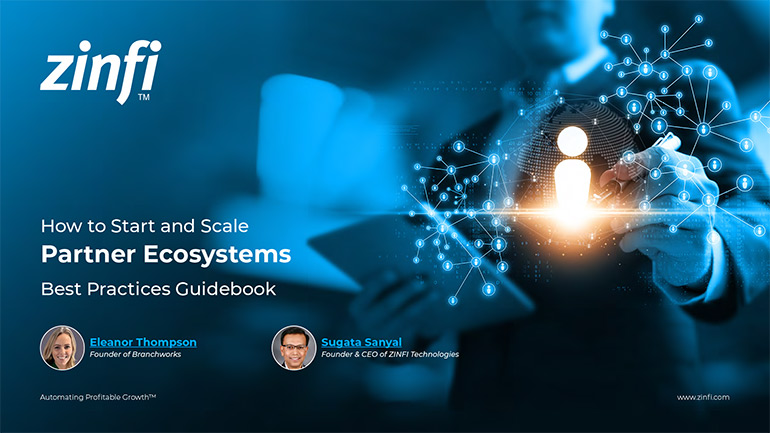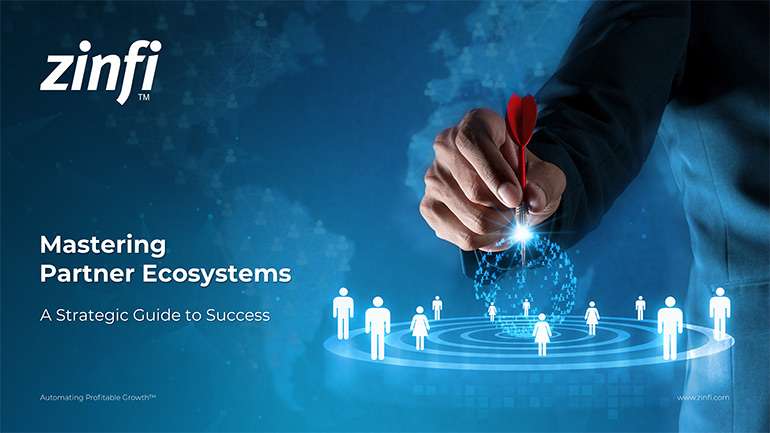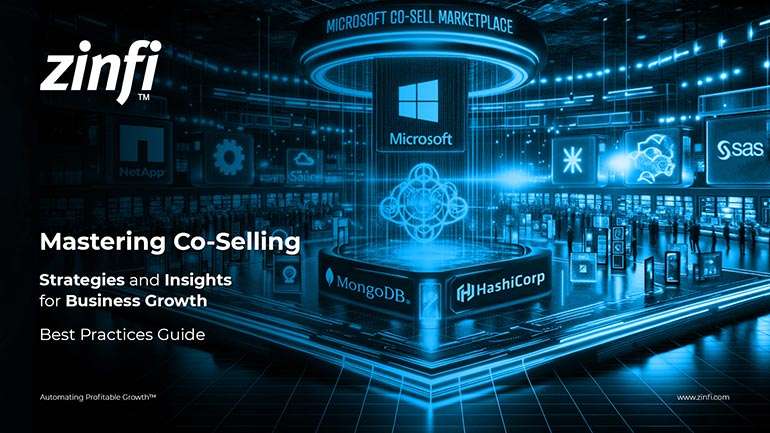Best Practices Articles

Five Steps to Best-in-Class Channel Management Using PRM
We have discussed in multiple articles why channel management is complex. With that said, if you are selling through the channel, then there are specific steps your organization can take to foster the right approach to partner relationship management (PRM) and build a truly high-performing channel. The goal of PRM is not just to lay out an automated end-to-end foundation to manage partner relationships better. That’s important, of course, but the right approach to PRM also allows organizations selling through the channel to move up the ladder of channel maturity more quickly, in five sequential steps. In this article, we will explore how PRM can enable an organization to achieve best-in-class performance by proceeding in a logical sequence through these five essential steps.
Step 1: Laying the foundation
The goal in this step is to make sure partners can interact with a vendor on a 24x7 basis. Why is that important? Because we live in a 24x7 economy, which is almost entirely digital. Depending on the solution (finance, real estate, insurance, high tech, etc.) you are selling through your channel—captive or shared—it is important to make sure your channel partners or dealers or brokers have an easy way to interact with you. Email and phone-based communication are not only barely sufficient, but also lack continuity.
Therefore, to properly lay the foundation an organization must set up a partner portal, basic contracts and a clear value proposition for the program. To accomplish this, you will need a state-of-the-art PRM platform, as well as a comprehensive channel program. This program should clearly articulate the partner tiers, and what partners need to do to move from one tier to the next. This may sound basic, but many organizations fail to properly think it through from the partner perspective. While it may be important for you to attain certainly profitability targets, it’s difficult to meet those targets consistently if your partners are not profiting from selling your solutions. So, in this foundational stage, you should make sure the partner program and its polices are clearly articulated via the partner portal.
In addition to laying out your channel program and policy as you drive recruitment to grow your partner base, you will also have to manage your partner tiers. This is where your PRM system should enable you to dynamically manage the partner base. It is surprising to see, even at this advanced stage of digital business transformation, that most organizations manage their partner base using either a CRM system or Excel. We have explained in previous articles why CRMs don’t work for PRM. You truly need a dedicated PRM solution.
Step 2: Enabling partners to sell
Once you have a basic partner program and portal going, the next target of focus needs to be on sales enablement. After all, what’s the use of having an indirect (partner) sales force if they lack the ability to sell? The more complex your solutions are, the more thought you should put into partner sales enablement activities. Your product marketing and management should provide support, but—once again—to be truly effective in sales enablement you also need a PRM platform that can automate the publishing and distribution of sales content across various partner segments and tiers, and across multiple languages and countries.
While most organizations tend to have some sort of a partner portal with sales materials and other assets, these assets are rarely used effectively. A state-of-the-art PRM platform should enable you to stair-step the partner base through various products and solutions, as well as through various sales stages. In this digital age of procurement, whether a consumer is buying a house or a purchasing agent is searching for state-of-the-enterprise software, the search begins online. However, once the prospective buyer has educated herself, she will go directly to the vendor or to a partner (from the vendor website) looking for sales support. If a partner sales rep engages but is not well-versed in the various features and benefits of the solution, then that prospective buyer will quickly switch vendors. This happens every day.
Therefore, it is essential in this second step that an organization selling through the channel deploy a PRM system that not only stair-steps the training across various products and solutions, but also gives the vendor the ability to track and understand the maturity of its channel salesforce. This includes training, but also testing and certification. While you can certainly deploy a standalone learning management system, a best-in-class PRM system should enable you to perform this step more efficiently by allowing tracking and management of partner competencies (e.g., certifications) by various tiers and partner types. To optimize this step, you need a PRM system that can tell you quickly who can sell well, and who still needs help.
Step 3: Incentivizing partners to sell more
Now that you have laid out the foundation to interact with your partners and have enabled them to sell, the next step is to focus on incentivizing them to sell more. To do this, you must track their sales volumes, competencies and overall business plans and objectives. In the case of single-brand product distribution via the channel—for example, franchises—it is relatively easy to track performance. However, to incentivize and manage sales via multi-vendor channel sales organizations is quite complex. In the latter scenario, you are constantly vying for mindshare, and you are paying for it in some way or another.
If you are a business-to-consumer (B2C) organization selling primarily to consumers through retail or other outlets (online or physical stores), you absolutely need a streamlined incentive program in the form of sales rewards and performance rebates that provide higher margins. Understanding partner profitability and motivation to sell more is critical. You can provide partners with all the training and sales assets you like, but if there is no clear financial pull from the partner it is hard to increase sales through a distributed partner network that is not only selling your products, but is also products from many other vendors. Your partners will be naturally incentivized to move in the direction of the vendor that provides them with the highest profitability in terms of more traffic to the store or higher margin per transaction. If you want to turn that dynamic to your advantage, you should carefully think through your incentives program.
This is where a state-of-the-art PRM platform can help you figure out, via business analytics, who is selling more and why, and how best to influence the sales dynamics and behavior. Channel management teams often make decisions based on anecdotal feedback from the partner base, and that’s why most channel incentives program do not work. However, if you can understand individual partners’ profit motives, and then design and distribute programs through an automated platform that can link your incentive dollars to your channel sales output, you can absolutely start building a cause-and-effect relationship between incentives and success. A PRM system is a critical enabler in this step.
Step 4: Helping partners with lead generation
In case of B2C selling in the channel, vendors typically do most of the marketing and drive leads to local entities such as franchises, captive stores or outlets. However, in certain franchise or distributed B2C models, local stores and units drive their own marketing. In the case of the business-to-business (B2B) sales channel, partners tend to be responsible for generating their own sales opportunities and leads. While the vendor certainly drives lead generation and category and solution awareness, and distributes those leads to indirect (channel) sales teams, successful partners will figure out how to drive marketing on their own.
To help distributed franchises, stores or indirect channel sales teams generate leads, the vendor organization needs a PRM system that has multi-level marketing built in. It is essential in this step of maturity to enable partners with a marketing strategy for lead generation by leveraging vendor-provided assets and programs like campaign-in-a-box. While most vendors who are at this stage provide partners with some level of marketing and sales assets, if they are managing a broad channel it is also necessary to have a PRM tool that has through-partner marketing programs built in with integrated digital and analog marketing capabilities.
A best-in-class PRM system should come with both inbound (search, social and web syndication) and outbound (email, microsite, event, etc.) capabilities. A vendor should be able to upload predesigned campaign assets into this platform, and partners should be able to execute integrated campaigns with just a few clicks. In many cases, vendors may also provide local marketing agency support, as many partners do not have captive marketing capabilities. Vendors need a PRM tool that not only completely automates the delivery of campaign assets to partners, but also allows vendors to track what how campaigns are performing and understand how to improve them.
Step 5: Maximizing channel ROI
The last step in this journey is to make sure that all your systems are running in sync and that you have full visibility into what is happening. Very few organizations achieve this stage of maturity. While it is possible to skip steps 1 through 4 to get here quickly, you must have comprehensive channel programs and policies that are laser-focused on partner profitability and sustainability. You must also build end-to-end automation that not only reduces your training and sales enablement costs dramatically, but also drives up adoption among your partner base regarding training attendance, certification achievement and sales capability improvement.
Your channel incentive programs at this stage should be linked directly to partner performance. Partner functional organizations should be fully aware of how they can drive profitable growth by leveraging your incentive programs. Your PRM system should be able to show you this linkage in a very direct way. The lead generation programs that you develop will also incentivize partners to do more on their own, rather than just relying on you to provide leads and opportunities.
Once you align all your PRM subsystems—programs, policies, people and platform—you should be able to attain a level of performance that is not easily achievable by your competitors. This is a huge advantage. The alignment of these PRM components will also substantially increase partner loyalty and satisfaction. The more engaged and focused your partner base is on your products and solutions, the lower your “market to” and “sell to” costs are going to be, which gives you another advantage over competitors. This state is certainly achievable, but it requires multi-quarter planning and execution focus to achieve. It also requires a best-in-class PRM platform that will enable you to succeed on a global scale—not just in one territory or country, but all around the world.
As you can see, the five steps I have laid out to build a high-performing channel and a high level of channel maturity are achievable. However, it does require that organizations combine longer-term planning with a short-term execution focus to move steadily up the maturity ladder. Rome wasn’t built in a day, nor is a high-performing channel. To maximize channel ROI you must adopt a long-term approach and then make your channel teams accountable for getting things done in a step-by-step fashion that resembles the outline I’ve provided above, which is based on decades of channel management experience and our day-to-day interactions with enterprise clients around the world.
Best Practices Guidebook
 The Ultimate Guide to Partner Marketing Success Best Practices
The Ultimate Guide to Partner Marketing Success Best PracticesDownload Guide
 How to Start and Scale Partner Ecosystems Best Practices
How to Start and Scale Partner Ecosystems Best PracticesDownload Guide
 The Evolution of PartnerOps: Past, Present & Future Best Practices
The Evolution of PartnerOps: Past, Present & Future Best PracticesDownload Guide
 Mastering Channel Sales: Strategies, Best Practices, and Growth Tactics for 2025
Mastering Channel Sales: Strategies, Best Practices, and Growth Tactics for 2025Download Guide
 Winning with Partner Advisory Councils: Best Practices for Partner Engagement & Growth
Winning with Partner Advisory Councils: Best Practices for Partner Engagement & GrowthDownload Guide
 The Future of Partner Ecosystems Best Practices
The Future of Partner Ecosystems Best PracticesDownload Guide
 The AI Revolution: How Technology and Talent are Shaping the Future
The AI Revolution: How Technology and Talent are Shaping the FutureDownload Guide
 Top 105 Partner Management Metrics that Matter Best Practices
Top 105 Partner Management Metrics that Matter Best PracticesDownload Guide
 Mastering PRM Integration Best Practices
Mastering PRM Integration Best PracticesDownload Guide
 Building a Sales Partner Portal with Salesforce Best Practices
Building a Sales Partner Portal with Salesforce Best PracticesDownload Guide
 Building and Managing Partner Ecosystems Best Practices
Building and Managing Partner Ecosystems Best PracticesDownload Guide
 Mastering Co-Marketing and Co-Selling Best Practices
Mastering Co-Marketing and Co-Selling Best PracticesDownload Guide
 Transforming Partner Ecosystems Best Practices
Transforming Partner Ecosystems Best PracticesDownload Guide
 Mastering Partner Ecosystems Best Practices
Mastering Partner Ecosystems Best PracticesDownload Guide
 Mastering Partner Onboarding Best Practices
Mastering Partner Onboarding Best PracticesDownload Guide
 Partner Ecosystem Management Best Practices
Partner Ecosystem Management Best PracticesDownload Guide
 B2B Marketing in the Age of Intelligence Best Practices
B2B Marketing in the Age of Intelligence Best PracticesDownload Guide
 Multi-Partner Co-Selling Best Practices
Multi-Partner Co-Selling Best PracticesDownload Guide







